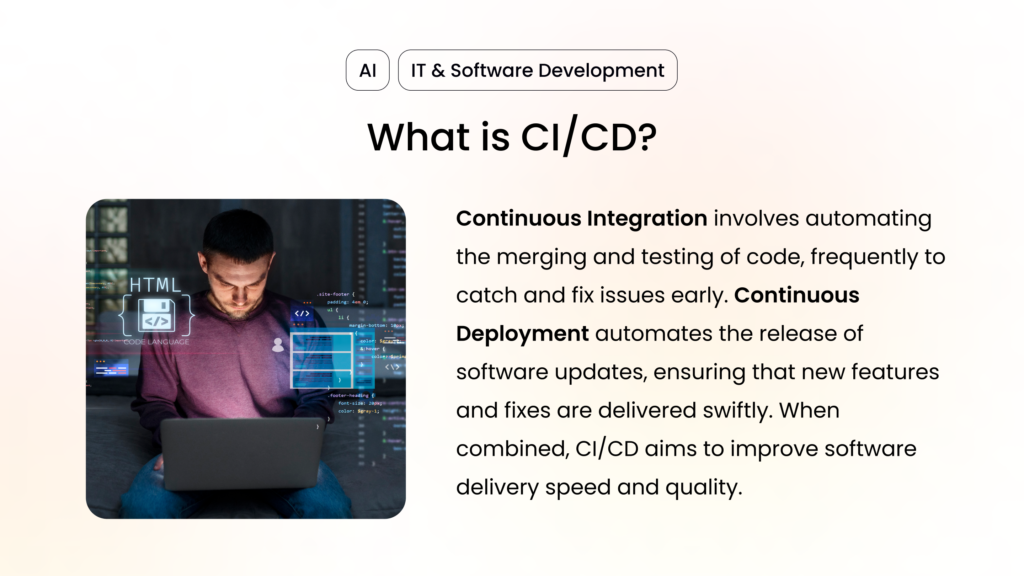In today’s fast-paced tech landscape, software delivery processes demand efficiency, accuracy, and speed. Enter Continuous Integration (CI) and Continuous Deployment (CD) – methodologies that streamline the path from code commit to production.
However, these processes can still be fraught with bottlenecks and inefficiencies. This is where Artificial Intelligence (AI) steps in. By integrating AI into CI/CD pipelines, software developers, CTOs, and tech managers can elevate their processes to new heights of productivity and reliability.
What is CI/CD?
Before we go any further, let’s establish a baseline understanding of CI/CD. Continuous Integration involves automating the merging and testing of code, frequently to catch and fix issues early. Continuous Deployment, on the other hand, automates the release of software updates, ensuring that new features and fixes are delivered swiftly. When combined, CI/CD aims to improve software delivery speed and quality.

10 Tips to Incorporate AI in CI/CD
AI has the potential to revolutionize how we approach CI/CD. By automating complex tasks and anticipating issues before they arise, AI can significantly reduce human workload and enhance the overall quality of the software delivery pipeline. This article will explore ten ways to incorporate AI in your CI/CD process, ensuring a more efficient and reliable workflow.
1. Automated Code Reviews
Automated code reviews are one of the most impactful ways AI can be integrated into CI/CD pipelines. Instead of manual reviews, which can be time-consuming and prone to human error, AI-powered tools can analyze code for adherence to coding standards and potential issues.
These tools can examine thousands of lines of code in seconds, identifying areas that need improvement. They can also learn from previous reviews, continually improving their accuracy. By catching issues early in the development process, AI-driven code reviews help maintain high code quality and reduce the likelihood of future bugs.
Furthermore, automated code reviews free up developers’ time, allowing them to focus on more complex tasks requiring human judgment. This results in a more efficient and productive development team.
2. Predictive Analytics for Build Failures
Build failures are a common challenge in CI/CD processes. They can disrupt the workflow and delay the release of new features. However, AI can help mitigate this issue through predictive analytics.
By analyzing historical build data, AI algorithms can identify patterns and predict potential build failures before they occur. This allows developers to proactively address issues, reducing downtime and improving the overall efficiency of the CI/CD pipeline.
Predictive analytics can also provide insights into the root causes of build failures, helping teams make informed decisions about how to prevent similar issues in the future. This results in a more stable and reliable software delivery process.
3. Intelligent Test Automation
Testing is a critical component of CI/CD, but it can also be resource-intensive. AI can optimize test automation by prioritizing and selecting test cases based on their importance and impact.
By analyzing past test results and code changes, AI can determine which test cases are most likely to identify issues. This reduces the time and resources needed for testing while maintaining high coverage and reliability. Intelligent test automation ensures that critical tests are performed first, catching significant issues early in the process.
Furthermore, AI can continuously learn and adapt its testing strategies, improving its effectiveness over time. This results in a faster, more efficient testing process that helps maintain high software quality.
4. Anomaly Detection in Deployment
Deploying software can be a complex process, and anomalies such as errors or performance degradation can occur. AI-driven anomaly detection can monitor deployment processes in real-time, identifying unusual patterns and alerting teams to potential issues.
By analyzing deployment data, AI can detect anomalies that might be missed by human observers. This allows teams to address issues quickly, minimizing downtime and reducing the impact on end-users. Anomaly detection ensures that deployments are smooth and reliable, improving the overall customer experience.
Additionally, AI-driven anomaly detection can provide insights into the underlying causes of anomalies, helping teams implement preventive measures and improve future deployments.
5. Automated Rollback
Deployment failures can have significant consequences, including downtime and user dissatisfaction. AI can help mitigate these risks by automating the rollback process.
AI systems can continuously monitor deployments and automatically trigger rollbacks in case of failures. This minimizes downtime and reduces the impact on end-users, ensuring that issues are resolved quickly and efficiently. Automated rollbacks provide a safety net for deployments, allowing teams to deploy with confidence.
Furthermore, AI can analyze the causes of deployment failures and provide insights for improving future deployments. This results in a more resilient and reliable software delivery process.
6. Performance Optimization
Ensuring that applications run efficiently in production environments is crucial for maintaining a positive user experience. AI can play a significant role in performance optimization by analyzing performance data and suggesting improvements.
AI algorithms can identify performance bottlenecks and recommend optimizations to improve efficiency. This includes optimizing resource usage, reducing latency, and improving overall application performance. Performance optimization ensures that applications deliver a smooth and responsive user experience.
By continuously monitoring and analyzing performance data, AI can help maintain optimal performance over time. This results in a more reliable and efficient software delivery process.
7. Smart Monitoring and Alerts
Monitoring is essential for maintaining the health and performance of software applications. AI-driven monitoring tools can provide intelligent alerts based on the severity and impact of detected issues.
By analyzing monitoring data, AI can identify critical issues and prioritize alerts accordingly. This helps teams respond more effectively, ensuring that important issues are addressed promptly. Smart monitoring and alerts improve the overall efficiency of incident response and reduce downtime.
Additionally, AI-driven monitoring tools can provide insights into the root causes of issues, helping teams implement preventive measures and improve future deployments.
8. Resource Allocation
Optimizing the allocation of computational resources during build and deployment processes is essential for the efficient use of infrastructure. AI can help achieve this by analyzing resource usage data and making recommendations.
AI algorithms can identify areas where resources are underutilized or overutilized and suggest adjustments to optimize resource allocation. This ensures that infrastructure is used efficiently, reducing costs and improving overall performance.
By continuously monitoring resource usage, AI can help maintain optimal resource allocation over time. This results in a more efficient and cost-effective software delivery process.
9. Continuous Security Testing
Security is a top priority for any software development process. AI can enhance security testing by continuously scanning the codebase for vulnerabilities and security issues.
AI-driven security tools can provide real-time feedback to developers, allowing them to address security concerns early in the development process. This improves the overall security posture of the application and reduces the risk of security breaches.
Continuous security testing ensures that security is an integral part of the CI/CD process, helping maintain high-security standards and protecting sensitive data.
10. Feedback Loop Improvement
Collecting and analyzing user feedback and operational data is essential for improving the software development process and product quality. AI can enhance feedback loops by providing insights and recommendations.
By analyzing user feedback and operational data, AI can identify areas for improvement and suggest changes to enhance the user experience. This helps teams make informed decisions about product development and prioritize features based on user needs.
Feedback loop improvement ensures that the development process is continuously optimized, resulting in higher-quality software and increased customer satisfaction.
Integrating AI into CI/CD
Integrating AI into CI/CD processes offers numerous benefits, including improved efficiency, reduced downtime, and enhanced software quality. By leveraging AI-driven tools and techniques, software developers, CTOs, and tech managers can revolutionize their workflows and stay ahead in the competitive software development landscape.
Whether it’s through automated code reviews, predictive analytics, intelligent test automation, or any of the other strategies discussed in this article, AI has the potential to transform CI/CD processes and deliver significant value to organizations.
Ready to take your CI/CD pipeline to the next level? Explore the possibilities of AI integration and unlock the full potential of your software delivery process with Innovators Hub Asia today.







